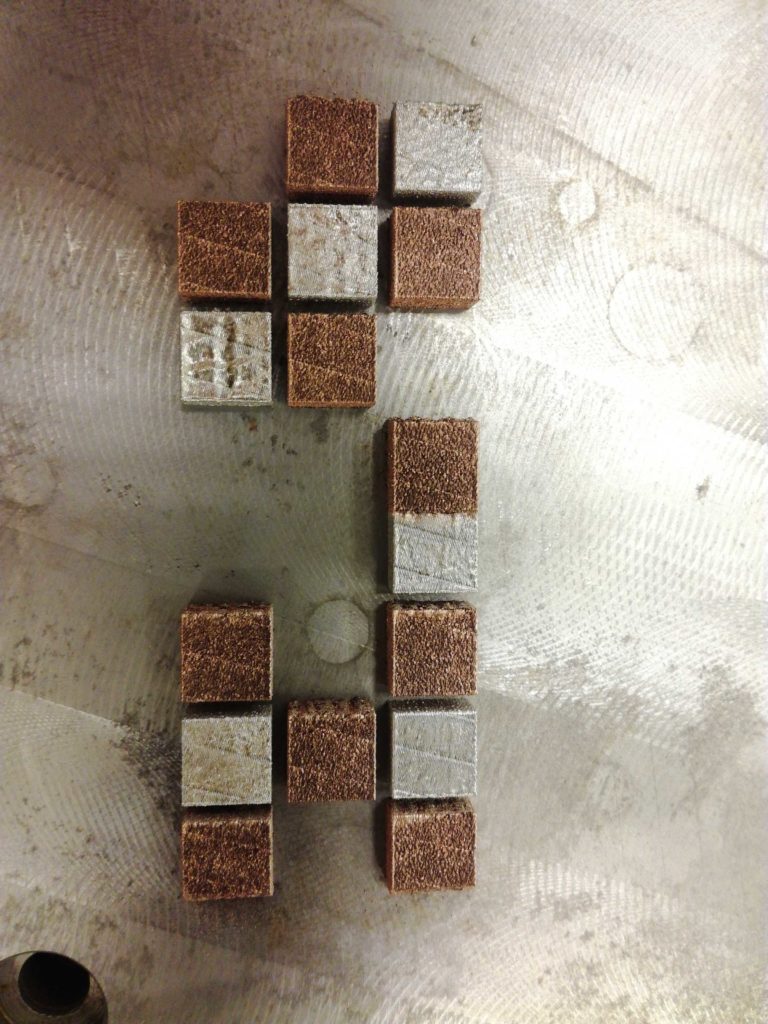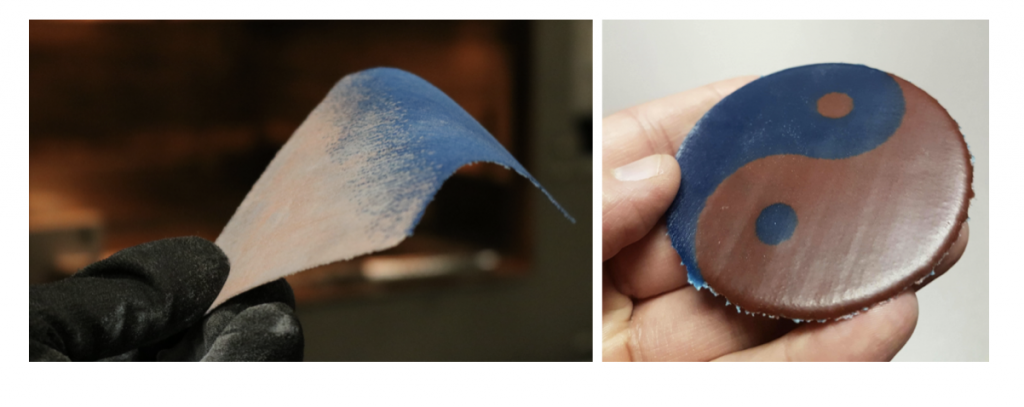Desktop Metal (NYSE: DM) has bought Aerosint, a firm that has developed a system capable of multi-material metal and polymer 3D printing on sintering systems. Aerosint’s technology can selectively dispense and sinter powder. This means that, for an expensive polymer such as PEEK, you can use only what you need and don’t have to spread an entire layer of powder out. For metal powders, you can mix multiple different metals into the same build. Aerosint also states that, “localized optimization of mechanical properties, such as wear resistance or vibration dampening, and improved chemical and physical properties, such as thermal and electrical conductivity, corrosion resistance, or aesthetics” are also possible.

The Aerosint multi-powder deposition process places expensive build powder (blue) only where needed, and inexpensive, non-fusible support powder (grey) everywhere else, virtually eliminating waste of unfused build powder. Example patterning (bottom right) where the dark powder is carbon black tinted PEEK and the white powder is alumina ceramic.
On the one hand, Aerosint may mean less material waste, while on the other hand it could mean more interesting new part properties by mixing dissimilar powders. At the moment, Aerosint’s recoater and software are meant to be integrated into an existing powder bed fusion machine. However, this acquisition could give Desktop Metal a path to go beyond its metal binder jetting technology, allowing it to develop its own powder bed fusion (PBF) system and eventually offer polymer and perhaps even metal PBF to the market. Perhaps Desktop Metal could acquire LSS or a similar smaller player to speed up the process of developing its own PBF machine a bit.
On the whole, this is yet more fuel for Desktop Metal’s attempt to acquire more revenue and technologies. With its acquisitions (of EnvisionTEC, for example), it is trying to sustain its stock price through hope and revenue. If investors buy it ,then Desktop Metal will continue on its buying spree and eventually may succeed in matching investors’ lofty expectations for it.
Last quarter, we saw that DM’s revenue was higher, but the company still lost $59 million for the quarter. The company is valued at $1.5 billion at the moment, which is quite high, especially since revenues last year were below $20 million. The firm’s stock price is eleven cents over the introduction price of $10 and this is off February highs, where the stock was up to $33.
Desktop Metal’s adventures are reminiscent of Icarus’s flight too close to the sun. Through sheer audacity, the firm did a SPAC and has been on an acquisition spree of late. If investors remain hopeful, then its success will have seen predestined, but Desktop Metal seems not to be installing very many of its own production systems for clients, at least publicly. There are very few announcements of people buying and using production units from the firm. Is the company buying time and will binder jet revenue catch up? Or will there be a lag, which will mean that it will be manifestly clear to investors that the firm will not make it? In that case, as Icarus, it will plummet earthward. It’s a close run and the outcomes are shaping up to be rather boolean. Either the firm will be a force to be reckoned with and a permanent presence among the largest companies in 3D printing or it will disappear.
3DPOD Episode 43: Powder Bed Fusion Innovations with Aerosint’s Edouard Moens de Hase
With regards to buying Aerosint, however, it remains to be seen in what timeframe the company can expand and offer the market a credible product with Aerosint’s technology. Having said that, Aerosint’s capabilities are very exciting and could really propel 3D printing forward. For the Aerosint team, this could be a good exit, since the path to revenue was rather fraught for the firm.
By relying on integrating with existing sintering systems, the company had made its path to market difficult. There were a lot of questions about machine IP and dependency, as well as the problem of integrating their technology into different equipment. While Aerosint’s technology is undoubtedly fantastic, I could not really plot a direction toward a flourishing business for them because they had painted themselves into a bit of a corner. Their sales cycles were just unimaginably complex and long, while dependencies lurked at every corner. With a sufficient level of investment, Aerosint could be a really exciting development.

Aerosint’s first trial 3D printing distinct cubes of copper alloy and stainless steel. Image courtesy of Aerosint.
Of the deal, Desktop Metal CEO Ric Fulop said,
“This transaction advances our strategy to own differentiated print technologies that enable an expanding set of AM 2.0 applications at scale. Multi-material printing is the next frontier in AM. Today people print parts, but in the future, people will look to print full products, which may be composed of multiple materials. Industrializing Aerosint’s core technology and related powder processing systems will provide many benefits to the broad adoption of AM solutions. We look forward to partnering with our new colleagues at Aerosint to mature this unique technology and integrate it into upcoming Desktop Metal products over the next several years. We are also excited for Aerosint to independently continue its growth trajectory by offering selective powder deposition solutions and services to third-party manufacturers and customers of powder-based AM systems.”
Aerosint CEO Edouard Moens de Hase stated,
“At Aerosint, we believe the future of AM is going to be multi-material. We are thrilled to partner with Desktop Metal to accelerate the execution of this vision, now with access to its scale, distribution network, and industry-leading AM 2.0 technology portfolio. We look forward to beginning a close collaboration with Desktop Metal while strengthening our ongoing efforts with our existing partners to transform the AM industry and capture new market opportunities.”

Multi-polymer print from Aerosint. Image courtesy of Aerosint.
Desktop Metal hopes to integrate the company’s technology into Desktop Metal’s offering in two years and Aerosint will operate as an independent subsidiary led by Edouard Moens de Hase. All in all, this could be an opportunity for Desktop Metal to commercialize a very interesting process that could give manufacturing firms new parts with new properties and help revolutionize manufacturing.
Subscribe to Our Email Newsletter
Stay up-to-date on all the latest news from the 3D printing industry and receive information and offers from third party vendors.
You May Also Like
3D Printing Financials: Fathom Struggles in Financial Quicksand During Critical Transition
Facing a year of key transitions and financial pressures, Fathom (Nasdaq: FTHM) has filed its annual report for 2023 with the U.S. Securities and Exchange Commission (SEC). The document outlines...
Latest Earnings Overview for Australian 3D Printing Firms Titomic and AML3D
Australian 3D printing manufacturing firms Titomic (ASX: TTT) and AML3D (ASX: AL3) reported their financial results for the period from July to December 2023, marking the first half of their...
3D Printing Webinar and Event Roundup: April 7, 2024
Webinars and events in the 3D printing industry are picking back up this week! Sea-Air-Space is coming to Maryland, and SAE International is sponsoring a 3D Systems webinar about 3D...
3D Printing Financials: Unpacking Farsoon and BLT’s 2023 Performance
In the Chinese 3D printing industry, two companies, Farsoon (SHA: 688433) and Bright Laser Technologies, or BLT (SHA: 688333), have recently unveiled their full-year earnings for 2023. Farsoon reported increases...































